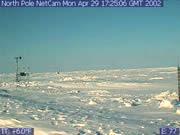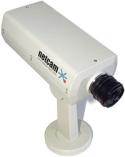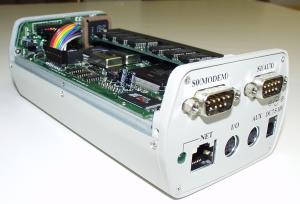Article: Penguins invade the North Pole!
May 4, 2002 — by LinuxDevices Staff — from the LinuxDevices Archive — 5 viewsTux-type Penguins, that is. Thanks to a project of the U.S. National Oceanic & Atmospheric Administration (NOAA), a webcam has for the first time been installed at the North Pole — one which runs on Embedded Linux, no less! The device was installed on April 28, 2002 and is now logging four images a day, which are available on NOAA's publicly accessible

The webcam contains a temperature sensor, allowing the temperature of its local environment to be monitored — note the temperature reading in the lower left-hand corner of the above photo (Click here for an enlarged photo). Various configuration parameters — including zoom, frequency of photos, and other camera settings — can be remotely configured via web access.

Vance Kozik, product manager for StarDot, says the NetCam contains an Internet-enabled computer running a version of the Linux operating system specially developed for microcomputers, called uClinux. The NetCam's embedded computer is based on a Motorola Coldfire microprocessor running at a 54 MHz clock rate, equipped with 8MB of RAM memory and 2MB of nonvolatile Flash memory. Input/output ports include a pair of RS232 serial ports, a 10 Mbits/sec Ethernet port, an I2C serial bus, and four bits of digital I/O. A close-up photo of the NetCam's embedded electronics is available here.
The NetCam implements a web server function using the open source Boa web server program. This allows it to be accessed remotely — from a web browser anywhere in the world — provided it is connected to the Internet via either its Ethernet interface or by means of a modem or wireless connection to one of its RS232 serial ports.

Inside the NetCam
Why use Embedded Linux?
“In 1999, when NetCam was only on the drawing board, we went through a whole list of possible microprocessor choices — primarily different flavors of ARM and MIPS,” recalls Kozik. “Whatever processor we would end up choosing, one thing was certain: it would have to run some form of Linux, since we'd already been using Linux for four years as our web server OS. Jim Treadway, our chief software engineer, immediately began converting our Windows webcam applications to run on a Linux box. From day one, we were fans of Linux. The then unheard of concept of an open source operating system that was more flexible and reliable than what the big boys were putting out was intoxicating.”
“The team settled on the Motorola Coldfire 5206e as NetCam's processor, primarily for its low price,” Kozik adds. “Luckily, Greg Ungerer (then of Moreton Bay, an Australian company subsequently acquired by Lineo) had recently ported uClinux to the Coldfire family. After downloading and compiling his source and getting it to load on the Coldfire development board, we were off to a running start. Although we knew there would be many hurdles to jump to get uClinux running in our camera, the very fact that we had a powerful open source operating system at our disposal made the job much easier.”
The embedded software
“From an embedded software perspective, we had a few basic requirements, and we threw in some extras,” continues Kozik. “NetCam had to be IP-addressable and run a web server. We settled on Boa. Although Boa certainly has some limitations, it did allow us to support server side scripts, a necessity when a web browser is the customer's primary interface to device. The other base requirement was to have the ability to FTP images to an external web server. These were both fairly straightforward to achieve, since they were part of the uClinux release — although Jim Treadway did have to modify the source.”
In addition to the bare essentials, the team also developed (or modified) the required software to implement these capabilities:
- Synchronizing NetCam's internal clock with an external time server (via rdate)
- A Telnet server
- Passing parameters to/from other chips via the Coldfire processor's I2C bus
- Security via account names and passwords
- PPP/PAP/CHAP/CHAT support for ISP dial-up
- Controlling all of the camera's imaging functionality, including color processing, color balance, image sharpen, contrast enhancement, and JPEG compression
Here are the specs of the resulting uClinux based webcam . . .
- Imaging:
- Sharp 1/3 CCD sensor, 640×480 RGB, Frame Transfer
- Exposure range: 0.00001 to 1.3 seconds
- Auto/manual exposure, auto/manual color balance, sharpening
- Contrast enhancement, gamma correction
- Customizable date/time/text overlay
- Image format: JPEG, adjustable quality/filesize
- Transfer speed, 320×240: LAN, 2-3 seconds; modem, 5-10 seconds
- Transfer speed, 640×480: LAN, 7-8 seconds; modem, 8-20 seconds
- Lens: 8mm C-Mount with manual iris and focus rings
- Lens Mount: Industry standard CS-Mount, includes C-Mount adapter
- Sharp 1/3 CCD sensor, 640×480 RGB, Frame Transfer
- Embedded computer:
- CPU: Motorola Coldfire, 54MHz
- Memory: 8MB DRAM; 2MB Flash
- Operating system: uClinux
- Built-in web server, telnet server, and FTP client
- Supported protocols: TCP/IP, HTTP, FTP, ARP, Telnet, Daytime
- Security: password protected user accounts for viewing and configuring NetCam
- CPU: Motorola Coldfire, 54MHz
- Connectivity:
- 10-baseT Ethernet, RJ45
- 2 RS232 serial ports, DB9M, up to 115.2Kb/sec
- 4 digital I/O for alarm inputs or general purpose outputs
- fully isolated relay or photo flash trigger, rated at 28VDC 2A or 125VDC 0.5A
- 5VDC 50mA regulated power supply
- 10-baseT Ethernet, RJ45
- Physical:
- Dimensions: 3.25 x 2.20 x 6.56 in. (included lens adds 1.1 in. to length)
- Weight: 19.5 ounces
- Case: aluminum clam shell body, argentan alloy front cover
- Mounting: universal tripod mount, top or bottom of camera
- Operating temperature: -40 to +48 deg. C
- Power requirements: 7.2VDC-10VDC, 1A, 9VDC power supply included
- EMI Approval: FCC, Class A
- Dimensions: 3.25 x 2.20 x 6.56 in. (included lens adds 1.1 in. to length)
What makes StarDot's webcams different from commonly available low-end “USB cams” that sell for less than $100? Ordinary USB cams requiring a short USB tether to a dedicated PC don't lend themselves to remote outdoor placement, and don't support lens options, multiple camera operation, or high quality imaging. StarDot's high-end Internet-enabled webcams on the other hand, are specifically designed for remote imaging applications.
The webcams are often used to increase web site traffic. According to Kozik, webcam pages are among the best-linked pages on the net. For example, “the webcam pointing at the Old Faithful Geyser in Yellowstone Park currently accounts for nearly one half of the traffic on all U.S. national park websites combined”, he says.
An obvious use of remote imaging is in viewing things that would otherwise require traveling there. Suppose, for example, an alarm goes off or a piece of remote equipment sends a notification that something has gone wrong. Rather than sending an employee to the location (which could be quite costly and time consuming), a remote webcam could be used to observe whether a problem actually exists. Other possibilities include applications in construction, tourism, marketing, traffic control, building monitoring, surveillance, and security.
The future of remote imaging
According to Kozik, the world of remote imaging — such as NOAA's use for the NetCam at the North Pole is (ahem) “just the tip of the iceberg.”
“The number of installations and variety of uses for webcams is on the verge of exploding,” he says. “As wireless Internet technology becomes cheaper and more widespread, I predict that the remote imaging/video market will eventually overtake the digital camera consumer market — both tethered and portable. Virtually every room, parking space, vehicle, piece of equipment, and street corner will have some form of IP-addressable camera.” [Editor: Perish the thought!]
“And chances are, the majority of them will be powered by embedded Linux — it only makes sense,” adds Kozik. [Editor: ah, this is good ;)]
When can I get one and how much will it cost?
NetCam is available now for $599 in single piece quantities, and can be purchased directly from StarDot or via the company's reseller network.
This article was originally published on LinuxDevices.com and has been donated to the open source community by QuinStreet Inc. Please visit LinuxToday.com for up-to-date news and articles about Linux and open source.